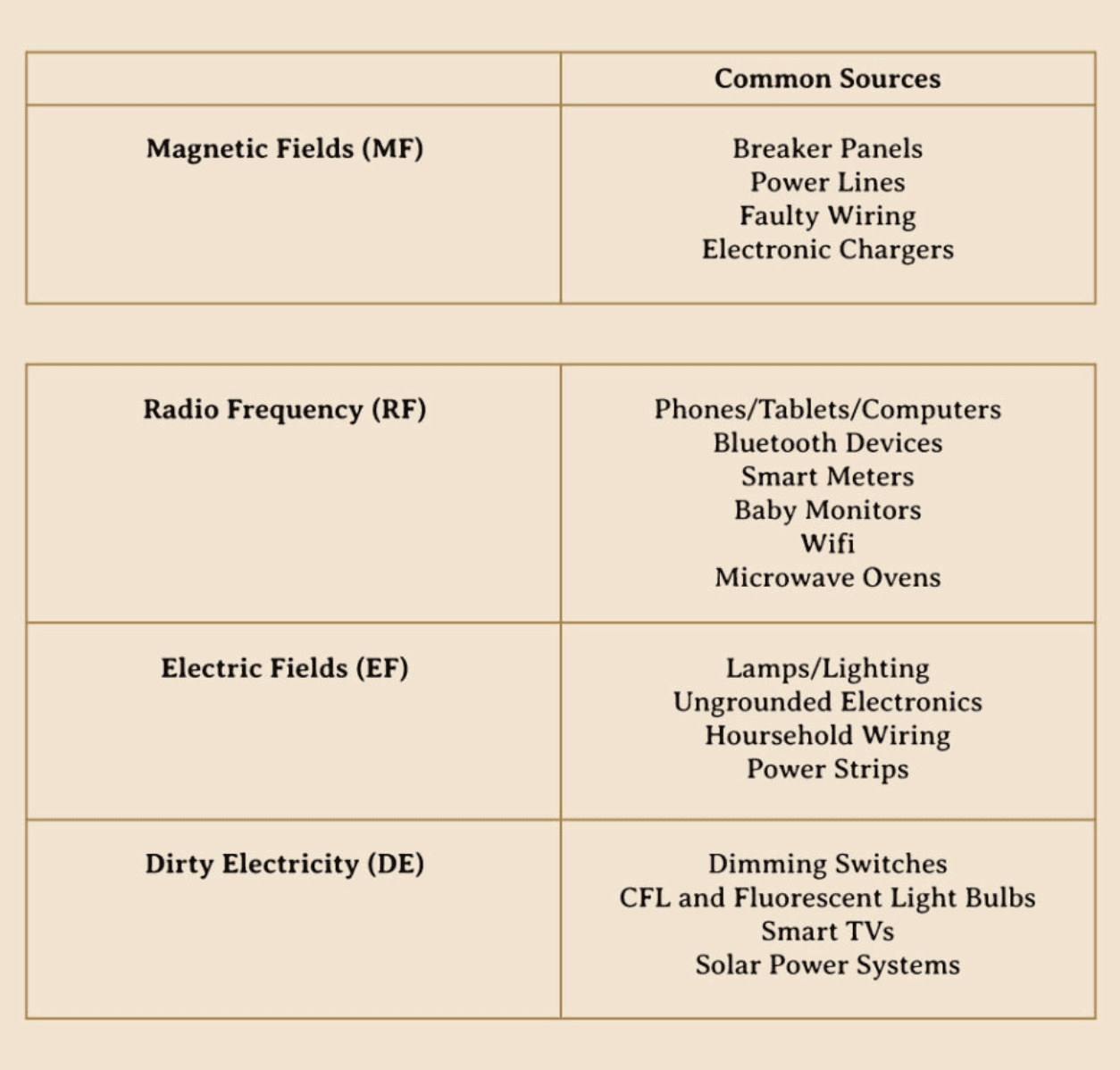Electromagnetic Fields
Living a healthy life in our modern world presents unique challenges, and one of them is the exposure to electromagnetic fields (EMFs) emitted by everyday electronic devices. We can’t ignore the importance of diet and lifestyle factors such as sleep, exercise, and stress management for achieving optimal health. However, it is crucial to recognize the impact of EMFs on our well-being. Let's explore this topic further.
EMFs refer to electromagnetic fields generated by electrically charged objects. In our daily lives, we are surrounded by cell phones, laptops, headphones, and other devices that expose us to various types of EMFs. While it is nearly impossible to completely avoid EMF exposure, there are steps we can take to mitigate their effects.
The good news is that not all EMFs are the same. In fact, both the human body and the Earth itself produce EMFs naturally, and every cell in our body has antennas that sense the electromagnetic environment. Our nervous system relies on electricity to enable essential functions such as thinking, feeling, and movement.
Although electromagnetic fields have always been a part of our world, the level of exposure has dramatically increased over the past few centuries, especially in recent decades.
EMFs are often overlooked because they are invisible, odorless, and generally undetectable without specialized equipment. However, constant exposure to EMFs has become a reality in our current environment due to the widespread presence of powerful 5G networks, billions of phones and computers, various smart devices, and extensive power line networks spanning the globe.
While some sources of EMF exposure are obvious, there are also less apparent sources. Here is a breakdown of the electromagnetic fields we are regularly exposed to, along with some common sources:
In addition to the extensive presence of EMFs in smart cities, we must also consider the numerous cell phones, laptops, smart TVs, routers, and other devices that surround us on a daily basis. Even in areas with lower exposure levels, we are constantly in the presence of these electromagnetic fields, whether we are aware of it or not.
The question arises: Are EMFs harmful? The answer is not entirely clear at this point. Despite the significant increase in EMF exposure in recent decades, there is still a lack of clarity regarding the long-term effects of EMFs due to a shortage of comprehensive long-term studies and efforts to understand their potential impacts. However, there are a few important findings that deserve consideration. Let's delve into them.
Further research is necessary to fully understand the potential health effects of EMFs. However, emerging evidence suggests that this is an aspect of maintaining a healthy lifestyle that requires closer attention. Here are some notable findings from studies on EMFs:
A study examining radiation from laptops, cell phones, microwaves, and WiFi indicated that RF frequencies from these devices may harm sperm count, motility, and morphology.
A review concluded that EMF exposure could contribute to oxidative stress in bodily tissues.
Numerous studies on WiFi have demonstrated that exposure can cause damage to sperm and testicular tissues, apoptosis, endocrine changes, cellular DNA damage, and calcium overload.
A systematic review and meta-analysis from 2014 found that cell phone usage, in combination with other environmental factors, may have a negative impact on sperm quality.
A study on immature and mature rats observed that radio-frequency electromagnetic fields (RF-EMF) resulted in damaged genetic material.
EMFs may contribute to an increased risk of acoustic neuroma and glioma, be a risk factor for breast cancer in women, and have the potential to alter gene expression in specific cell types.
A study conducted on a group of 60 individuals in Germany before and after the installation of a cell phone base station showed that the activation of the transmitter may have decreased dopamine levels. Sensitive populations also experienced significant increases in adrenaline and noradrenaline levels.
While most of these studies highlight the need for longer-term human studies, it is increasingly recognized that EMFs can have negative impacts on health.
To help you minimize the potential harmful effects of EMF exposure, here are three essential steps you can take:
Remove the source, if possible: Radio frequencies (RF) tend to increase as we get closer to devices. Whenever feasible, create distance between yourself and your devices. Interestingly, Apple includes a similar recommendation in their phone settings. iPhone users can go to Settings → General → Legal & Regulatory → RF Exposure to find information on reducing exposure to RF energy. Using hands-free options like the built-in speakerphone, headphones, or other similar accessories can help. It's worth noting that certain phone cases analyzed by the Environmental Working Group were found to potentially intensify radiation to the head or other body parts.
Limit proximity and duration: If removing the source is not possible, try to limit the amount of time you spend near devices emitting EMFs. EMFs are classified based on their wavelength and frequency. Power lines, for example, have longer wavelengths and lower frequencies. On the other end of the spectrum are X-rays, which have shorter wavelengths and higher frequencies that can be more damaging to the body. This is why protective vests are worn during X-ray procedures at the dentist.
Shielding and protection: Explore options for shielding or protecting yourself from EMFs. For example, you can use EMF-blocking materials or devices that reduce your exposure when using electronic devices. Additionally, consider creating an EMF-safe zone in your home by minimizing the use of wireless devices or using shielding materials for your bedroom.
By implementing these principles, you can take proactive steps to reduce your EMF exposure and promote a healthier environment for yourself.
Let's explore additional steps you can take to minimize EMF exposure from handheld devices without relying on complex gadgets:
Activate airplane mode: Airplane mode is not just for plane rides. Use it on your devices and turn off the Wi-Fi and Bluetooth components when you're not using them. This helps stop radio frequency transmissions.
Use wired headphones: Bluetooth devices emit radio frequencies as they constantly send out signals. Many of these devices also come into direct contact with the body. Opt for wired headphones instead.
Limit phone usage with weak signal: Phones tend to increase their power when searching for a signal. Whenever possible, use your phone in areas with a strong signal to minimize exposure.
Utilize speakerphone or wired headphones for calls: Texting emits less radiation, but if you need to make a call, use the speakerphone or wired headphones. The head is considered one of the body's most vulnerable areas to EMFs.
Practice safe storage: Avoid storing devices in pockets, bras, or other areas in close contact with the body. If you need to carry devices in these areas, activate airplane mode and turn off Wi-Fi and Bluetooth functions. Consider using Faraday bags for an extra layer of protection.
Travel safely: Using devices in a car or other modes of transportation can cause them to work harder for a signal and reflect off metal surfaces, leading to increased exposure. If possible, download podcasts or music beforehand and listen in airplane mode. Opt for an auxiliary cord instead of a Bluetooth connection.
By implementing these practical tips, you can reduce your daily EMF exposure and promote a safer environment for yourself and your loved ones.
The principles we discussed earlier can also be applied to reduce EMF exposure from computers:
Opt for wired devices: Choose wired options for your mouse, keyboard, printer, and other peripherals. This creates distance between you and the computer, minimizing EMF exposure.
Avoid using laptops directly on your lap: As mentioned before, it's important to avoid direct contact between laptops and your body.
Use hard-wired Ethernet cables with an Ethernet grounding kit: Utilize Ethernet cables for internet connection and consider using an Ethernet grounding kit to reduce EMFs in your home. This may require coordination with your internet provider.
Utilize grounded charging cables: Opt for three-pronged charging cables for devices to reduce electric fields. This concept can be applied to plug-ins for lamps and other household items as well.
Focusing on EMF reduction in the bedroom is particularly important since we spend a significant amount of time there. Consider these habits for a restful sleep:
Unplug Wi-Fi at night or use a Wi-Fi timer: Disconnecting or using a timer to turn off Wi-Fi during sleep helps reduce EMF exposure, especially if your sleeping area is close to the router.
Unplug unused electronic devices at night: Turn off and unplug electronics like lamps, microwaves, and phone chargers when not in use. These devices can emit electric fields when plugged in. Charge devices away from your sleeping area and keep them on airplane mode.
Use a battery-powered alarm clock: Replace your phone as an alarm clock with a battery-powered alternative to minimize electronics in the bedroom and reduce phone usage before bed.
Consider turning off electricity in your room at night: If feasible, turning off the electricity in your bedroom can quickly reduce electric fields that may be present in the walls.
Minimize clutter: Reduce the presence of metal items in your room, including bed frames and mattresses, as they can attract additional EMFs.
Avoid CFL and fluorescent light bulbs: These types of bulbs can generate dirty electricity and contain mercury. Opt for incandescent bulbs or use candles for nighttime lighting.
Consult a "building biologist": If you want to go the extra mile in minimizing EMFs, consider seeking advice from a professional "building biologist" who can help protect your home or office.
While further research is needed to fully understand the health impacts of EMFs, taking these simple steps can help reduce your exposure. It's essential to acknowledge that computers, phones, and other devices are likely to remain integral to our lives. By proactively implementing these measures, you can mitigate the potential harm of EMF exposure.
Remember, focusing on a healthy diet, sunlight exposure, and regular movement are powerful factors in improving overall health. These lifestyle choices can act as a counterbalance to the EMFs we encounter in our daily lives. By combining a healthy body with the 19 steps mentioned above, you'll be ahead of the curve in minimizing the potential effects of EMFs.



